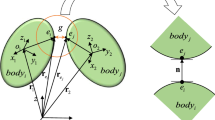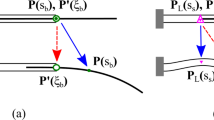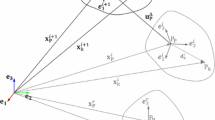Abstract
This paper studies the energy–momentum conserving integration for large flexible dynamic systems combining the node-to-element sliding contact pair, which suffers strong coupling between deformation modes and large-scale sliding motion. Unlike node-to-node contact, the sliding contact pair places higher demands on smoothness of geometry description and reduction of material nonlinearity as the contact generally occurs on lines or surfaces. To maintain contact transition continuity, it is necessary to cautiously implement the interpolation of relative kinematic constraints. Moreover, the numerical treatment of auxiliary non-generalized variable influences the accuracy and stability in solving differential-algebraic system. To solve these problems, this paper has made improvements from the two aspects of flexibility description based on the rotationless director triad and isogeometric interpolation, and energy–momentum conserving integration. The treatment of sliding parameter derived from constraint equations is synchronized with that of the generalized variables in differential-algebraic system. Compared with three commonly used numerical methods, this integration shows advantages in strong robustness, conservation properties and convergence verified by typical numerical examples. Novel results are obtained for the sliding joint flexible multibody system revealing the performance of accuracy and robustness in complex dynamics.


















Similar content being viewed by others
Data availability
All data generated or analyzed during this study are included in this published article.
Change history
10 August 2022
A Correction to this paper has been published: https://doi.org/10.1007/s11071-022-07759-y
References
Gay Neto, A.: Simulation of mechanisms modeled by geometrically-exact beams using Rodrigues rotation parameters. Comput. Mech. 59(3), 459–481 (2017)
Mäkinen, J.: Total Lagrangian Reissner’s geometrically exact beam element without singularities. Int. J. Numer. Methods Eng. 70(9), 1009–1048 (2007)
Giorgio, I.: A discrete formulation of Kirchhoff rods in large-motion dynamics. Math. Mech. Solids 25(5), 1081–1100 (2020)
Ghosh, S., Roy, D.: Consistent quaternion interpolation for objective finite element approximation of geometrically exact beam. Comput. Methods Appl. Mech. Eng. 198(3–4), 555–571 (2008)
Zhong, H., Zhang, R., Xiao, N.: A quaternion-based weak form quadrature element formulation for spatial geometrically exact beams. Arch. Appl. Mech. 84(12), 1825–1840 (2014)
Simo, J.C.: A finite strain beam formulation. The three-dimensional dynamic problem. I. Comput. Methods Appl. Mech. Eng. 49(1), 55–70 (1985)
Ghosh, S., Roy, D.: A frame-invariant scheme for the geometrically exact beam using rotation vector parametrization. Comput. Mech. 44(1), 103–118 (2009)
Romero, I., Armero, F.: An objective finite element approximation of the kinematics of geometrically exact rods and its use in the formulation of an energy-momentum conserving scheme in dynamics. Int. J. Numer. Methods Eng. 54(12), 1683–1716 (2002)
Leyendecker, S., Betsch, P., Steinmann, P.: Objective energy–momentum conserving integration for the constrained dynamics of geometrically exact beams. Comput. Methods Appl. Mech. Eng. 195(19–22), 2313–2333 (2006)
Betsch, P., Sänger, N.: On the consistent formulation of torques in a rotationless framework for multibody dynamics. Comput. Struct. 127, 29–38 (2013)
Saravia, C.M., Machado, S.P., Cortínez, V.H.: A geometrically exact nonlinear finite element for composite closed section thin-walled beams. Comput. Struct. 89(23–24), 2337–2351 (2011)
Saravia, C.M.: A large deformation–small strain formulation for the mechanics of geometrically exact thin-walled composite beams. Thin-Walled Struct. 84, 443–451 (2014)
Meier, C., Popp, A., Wall, W.A.: An objective 3D large deformation finite element formulation for geometrically exact curved Kirchhoff rods. Comput. Methods Appl. Mech. Eng. 278, 445–478 (2014)
Meier, C., Popp, A., Wall, W.A.: Geometrically exact finite element formulations for slender beams: Kirchhoff–Love theory versus Simo–Reissner theory. Arch. Comput. Methods Eng. 26(1), 163–243 (2019)
Shabana, A.A., Yakoub, R.Y.: Three dimensional absolute nodal coordinate formulation for beam elements: theory. J. Mech. Des. 123(4), 606–613 (2001)
Dmitrochenko, O.N., Hussein, B.A., Shabana, A.A.: Coupled deformation modes in the large deformation finite element analysis: generalization. J. Comput. Nonlinear Dyn. 4(2), 146–154 (2009)
Nachbagauer, K., Pechstein, A.S., Irschik, H., Gerstmayr, J.: A new locking-free formulation for planar, shear deformable, linear and quadratic beam finite elements based on the absolute nodal coordinate formulation. Multibody Syst. Dyn. 26(3), 245–263 (2011)
Gerstmayr, J.: A corotational approach for 3D absolute nodal coordinate elements. In: International Design Engineering Technical Conferences and Computers and Information in Engineering Conference, vol. 49019, pp. 973–981 (2009)
LaBudde, R.A., Greenspan, D.: Energy and momentum conserving methods of arbitrary order for the numerical integration of equations of motion. Numer. Math. 26(1), 1–16 (1976)
Simo, J.C., Tarnow, N.: The discrete energy–momentum method. conserving algorithms for nonlinear elastodynamics. Z. Angew. Math. Phys. ZAMP 43(5), 757–792 (1992)
Gonzalez, O.: Time integration and discrete Hamiltonian systems. J. Nonlinear Sci. 6(5), 449–467 (1996)
Gonzalez, O.: Exact energy and momentum conserving algorithms for general models in nonlinear elasticity. Comput. Methods Appl. Mech. Eng. 190(13–14), 1763–1783 (2000)
Munoz, J.J., Jelenić, G.: Sliding joints in 3D beams: conserving algorithms using the master–slave approach. Multibody Syst. Dyn. 16(3), 237–261 (2006)
Leyendecker, S., Betsch, P., Steinmann, P.: The discrete null space method for the energy-consistent integration of constrained mechanical systems. Part iii: flexible multibody dynamics. Multibody Syst. Dyn. 19(1), 45–72 (2008)
Romero, I.: An analysis of the stress formula for energy-momentum methods in nonlinear elastodynamics. Comput. Mech. 50(5), 603–610 (2012)
Betsch, P.: Energy-momentum integrators for elastic cosserat points, rigid bodies, and multibody systems. In: Structure-preserving Integrators in nonlinear structural dynamics and flexible multibody dynamics, pp 31–89. Springer (2016)
Gebhardt, C.G., Hofmeister, B., Hente, C., Rolfes, R.: Nonlinear dynamics of slender structures: a new object-oriented framework. Comput. Mech. 63(2), 219–252 (2019)
Orden, J.C.G.: Energy and symmetry-preserving formulation of nonlinear constraints and potential forces in multibody dynamics. Nonlinear Dyn. 95(1), 823–837 (2019)
Hong, D., Ren, G.: A modeling of sliding joint on one-dimensional flexible medium. Multibody Syst. Dyn. 26(1), 91–106 (2011)
Sugiyama, H., Escalona, J.L., Shabana, A.A.: Formulation of three-dimensional joint constraints using the absolute nodal coordinates. Nonlinear Dyn. 31(2), 167–195 (2003)
Lee, S.-H., Park, T.-W., Seo, J.-H., Yoon, J.-W., Jun, K.-J.: The development of a sliding joint for very flexible multibody dynamics using absolute nodal coordinate formulation. Multibody Syst. Dyn. 20(3), 223–237 (2008)
Leyendecker, S., Betsch, P., Steinmann, P.: Energy-conserving integration of constrained Hamiltonian systems—a comparison of approaches. Comput. Mech. 33(3), 174–185 (2004)
Muñoz, J.J., Jelenić, G.: Sliding contact conditions using the master–slave approach with application on geometrically non-linear beams. Int. J. Solids Struct. 41(24–25), 6963–6992 (2004)
Espath, L.F.R., Braun, A.L., Awruch, A.M.: Energy conserving and numerical stability in non linear dynamic using isogeometric analysis. Mecánica Comput. 32(2), 33–62 (2013)
Eugster, S.R., Hesch, C., Betsch, P., Glocker, Ch.: Director-based beam finite elements relying on the geometrically exact beam theory formulated in skew coordinates. Int. J. Numer. Methods Eng. 97(2), 111–129 (2014)
Bonet, J., Wood, R.D.: Nonlinear Continuum Mechanics for Finite Element Analysis. Cambridge University Press, Cambridge (1997)
Romero, J.J.M.: Finite-element analysis of flexible mechanisms using the master–slave approach with emphasis on the modelling of joints. PhD thesis, University of London (2004)
Simo, J.C., Tarnow, N., Wong, K.K.: Exact energy–momentum conserving algorithms and symplectic schemes for nonlinear dynamics. Comput. Methods Appl. Mech. Eng. 100(1), 63–116 (1992)
Gerstmayr, J., Shabana, A.A.: Analysis of thin beams and cables using the absolute nodal co-ordinate formulation. Nonlinear Dyn. 45(1–2), 109–130 (2006)
Simo, J.C., Gonzalez, O.: Assessment of energy-momentum and symplectic schemes for stiff dynamical systems. In: ASME Winter Annual Meeting, American Society of Mechanical Engineers, New Orleans, Louisiana (1993)
Franke, M., Janz, A., Schiebl, M., Betsch, P.: An energy momentum consistent integration scheme using a polyconvexity-based framework for nonlinear thermo-elastodynamics. Int. J. Numer. Methods Eng. 115(5), 549–577 (2018)
Erlicher, S., Bonaventura, L., Bursi, O.S.: The analysis of the generalized-\(\alpha \) method for non-linear dynamic problems. Comput. Mech. 28(2), 83–104 (2002)
Guo, J., Betsch, P., Zhang, Y.: Structure-preserving algorithms for simple sliding contact constraint in director-based geometric exact beam. In: 14th WCCM-ECCOMAS Congress 2020: Collection of Papers Presented at the 14th Edition of the WCCM-ECCOMAS, Virtual Congress, January, 11–15, 2021. Ed.: F. Chinesta (2021)
Acknowledgements
A shortened version [43] of this research was published in the conference proceeding of the 14th WCCM-ECCOMAS Congress 2020. This paper provides substantial extensions and improvements, in which the dynamic model, conservation proof and simulation are refined. Additional analysis on the accuracy and convergence rate is provided. We also thank Prof. Peter Betsch for valuable guidance.
Funding
This research was supported by National Natural Science Foundation of China (Grant No. 12102316), China Scholarship Council (CSC) (Grant No. 201806120093), National Natural Science Foundation of Shaanxi Province (Grant No. 2020JQ-288) and Science and Technology on Space Intelligent Control Laboratory (Grant No. HTKJ2019KL502016).
Author information
Authors and Affiliations
Corresponding author
Ethics declarations
Conflict of interest
The authors declare that they have no conflict of interest.
Additional information
Publisher's Note
Springer Nature remains neutral with regard to jurisdictional claims in published maps and institutional affiliations.
Appendix A Proof of invariance of discrete strain measure
Appendix A Proof of invariance of discrete strain measure
Define the generalized coordinates \({{\varvec{q}}^\#}=\{ {\varvec{\varphi }}^\#, {\varvec{d}}^\#_I \}\) in a new configuration after superimposing the rigid body motion \(( {\varvec{\varphi }}_{R}, {\varvec{\Lambda }}_{R} )\) as
Inserting this transformation into Eqs. (47) and (48), the newly approximated position gives:
and the triad vectors become
Employing Eq. (A2), the axial generalized strain component in Eq. (19) is re-formulated as:
Likewise, the other scalar-valued strain components are:
Considering the superimposed rotation tensor satisfies \({ {\varvec{\Lambda }^{\mathrm{{T}}}_R} {\varvec{\Lambda }_R} = {\varvec{I}} }\), Eqs. (A4) and (A5) are derived as:
The B-spline basis function is the partition of unity given by \({\sum \limits _{A = 1}^{ne} {{N}^{A}} = 1}\), which leads to the evolved partial derivative condition:
Substituting Eq. (A12) into Eqs. (A8)–(A11), the objectivity relation \({\varvec{\epsilon }^{\mathrm{{h}}} ( {\varvec{q}} ^\# ) = \varvec{\epsilon }^{\mathrm{{h}}} ( {\varvec{q}} )}\) is confirmed:
Rights and permissions
About this article
Cite this article
Guo, J., Zhang, Y., Wei, C. et al. Energy–momentum integration and analysis for sliding contact coupling dynamics in large flexible multibody system. Nonlinear Dyn 110, 2333–2359 (2022). https://doi.org/10.1007/s11071-022-07707-w
Received:
Accepted:
Published:
Issue Date:
DOI: https://doi.org/10.1007/s11071-022-07707-w




